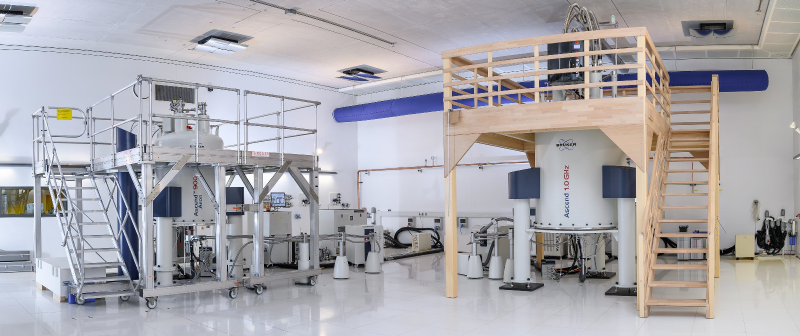The Henry Wellcome Building for Biomolecular NMR Spectroscopy was launched in 2004 as a national facility for biomedical research by the Wellcome Trust and Higher Education Funding Council for England.
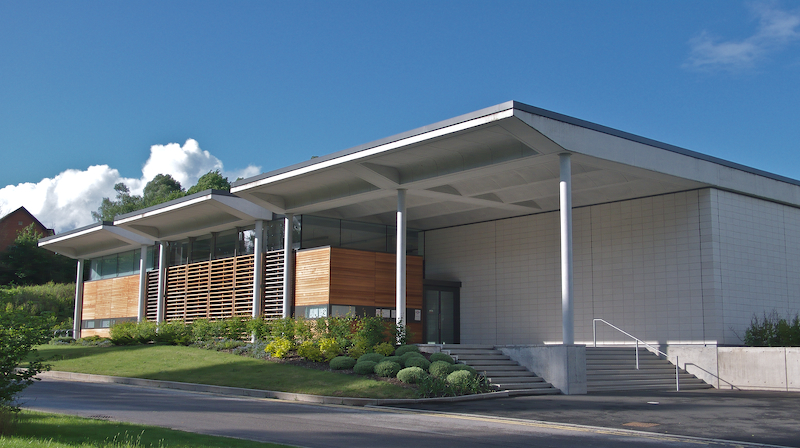
Key Events
2001:
Michael Overduin was recruited, and successfully applied for funding to acquire the 900 and 800 MHz NMR spectrometers and to construct the building.
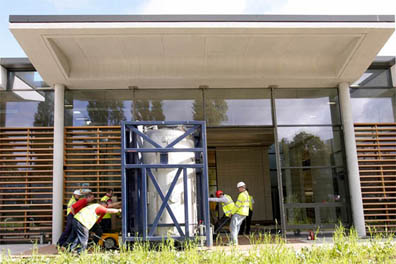
2002 - 2003:
The NMR spectrometers were purchased from Varian Inc, representing the single most expensive sale of NMR systems in Europe. Artist's rendition of the NMR building designed in 2002 by Berman Guedes Stretton.
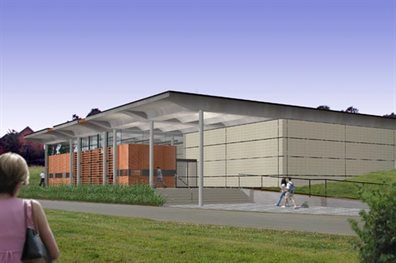
The NMR building's modular design by Berman Guedes Stretton was commended by Austin Williams in the Architect's Journal (19/9/2002).
The construction was begun by AWG Construction in July 2003 with nonferromagnetic materials, anti-vibration pads and all critical services duplicated. The building was finished 13 months later, and was featured by Geraldine Faulkner in the Contract Journal (25/9/2004).
2004 - 2007:
The Oxford/Varian 500, 600, 800 and 900 MHz NMR systems were installed, and a Wellcome Trust Equipment Grant is awarded to purchase an 800 MHz cryogenic probe.
The BBSRC Research Equipment Initiative awards the “Establishment of a European High Throughput NMR Centre for Metabolomics and Ligand Discovery” to purchase a high throughput screening station and upgraded 600 MHz NMR console at HWB•NMR.
The inaugural symposium “Magnets, Macromolecules and Medicine in the New Century” on 2 Nov 2004 was opened by a rousing lecture from Professor Richard Ernst, who was awarded the Nobel Laureate in Chemistry in 1991.
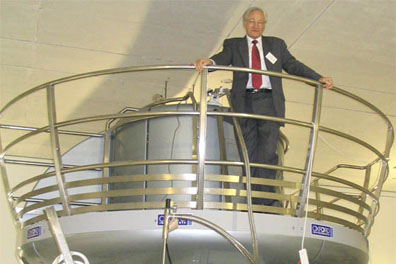
The design of the HWB•NMR was covered in the November 2005 issue of ‘Architecture Today’
HWB•NMR was one of five large scale NMR facilities funded by the European Commission from 2006 - 2010 to provide open access to users from across Europe (EU-NMR)
Funding from the BBSRC is used to purchase the world's first Actively Cooled Actively Shielded 600 MHz NMR magnet from Oxford Instruments and a 600 MHz cryogenic probe from Varian Inc.
One of the world's first HyperSense(TM) dynamic nuclear polarization instruments was installed by Oxford Instruments Molecular Biotools Ltd.
HWB•NMR was selected by the RIBA Higher Education Quality Forum “Distinction by Design” and exhibited in a national exhibition of exemplary higher education buildings.
2008 - 2012:
A Wellcome Trust Biomedical Resources grant is awarded in 2008, providing 4 years of support for national user access to the Varian 900 spectrometer.
Advantage West Midlands funds a "Metabolic Profiler" operating at 600 MHz in 2008, including a 1.7mm TCI cryogenic probe - the first of its kind in the UK. This is the first full Bruker system to be installed at HWB•NMR, a facility that was originally equipped only with Varian systems.
An Oxford Instruments E-Shield ES600 magnet (one of only two ever made, before Oxford Instruments calls it a day for NMR superconducting magnet production) replaces the prototype Oxford Actively Cooled Actively Shielded (ACAS) 600 MHz magnet in 2009 owing to problematic vibrations observed in spectra, originating from the pulse tube cryocooler. It would be several years later, in 2013, before the next generation of actively-cooled, actively-shielded magnets are perfected - by Bruker, with their Ascend Aeon magnet range.
HWB•NMR leads a 4-year European Commission funded FP7 IRSES grant, "World-wide NMR" (WW-NMR), by pulling together leading European NMR facilities with the aim of fostering trans-continental collaboration in the life sciences.
Trans-European access to NMR facilities continues for another 4 years from 2010 - 2014 with HWB•NMR partnering on the European Commission funded FP7 grant "Bio-NMR - NMR for structural biology".
2012 - 2017:
The Wellcome Trust Biomedical Resources grant is renewed in 2012, for 5 years, providing continued support for national user access. As part of the award, 600 and 900 MHz Varian consoles are upgraded to Bruker in 2013 (following Agilent Technologies' acquisition of Varian Inc. in 2010) including delivery of the first UK-based 600 MHz TXO cryogenic probe for 'proton-less NMR' for use by the UK community. A year later, in Oct 2014, Agilent exits its NMR business.
Since Sept 2015, on behalf of the Phenome Centre Birmingham, HWB•NMR has hosted two Bruker 600 IVDr systems for in vitro diagnostic research of clinical metabolomics samples. These highly optimised systems offer unrivalled reproducibility, enabling direct comparison of clinical data measured on identical systems anywhere in the world.
2017 - 2022:
The Wellcome Trust Biomedical Resources grant is renewed in 2017, for a further 5 years (and extended until 2024 owing to the SARS-CoV-2 pandemic which begins to take hold in Jan 2020), enabling continued support for national user access and the upgrade of the 12-year old Varian 800 spectrometer to Bruker's NEO console. The UK's first 1.7mm cryogenic probe operating at 800 MHz was delivered as part of the upgrade.
HWB•NMR leads a successful bid to host the UK's first solution-state 1.0 GHz NMR spectrometer as part of a £20m package awarded by the EPSRC/UKRI in Apr 2018 to overhaul UK very high-field NMR spectroscopy. After a couple of attempts to energise the magnet, it eventually reaches field in Oct 2021, and while still drifting slowly, is available for use from Jan 2022.
A shielded Bruker Aeon 900 MHz magnet, funded by the University of Birmingham, replaces the unshielded Oxford 900 (with a sizeable 5G stray field of >8m) in June 2021, which is successfully recommissioned at the Swedish NMR Centre in Gothenburg. This is the first Oxford 900 magnet to have been relocated and recommissioned anywhere in the world - an unprecedented and challenging project completed by UltraNMR, a dedicated team of three UK-based magnet experts.
HWB•NMR's new Director, Teresa Carlomagno, arrives in Birmingham on 1 Oct 2021 in time to celebrate the 1.0 GHz magnet reaching field.
